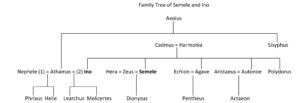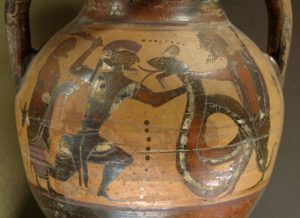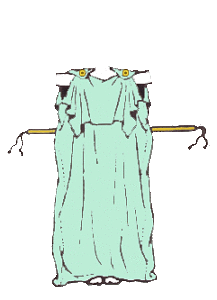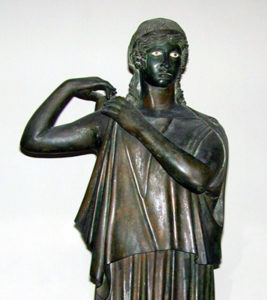[2] Κάδμος δὲ ἀνθ᾽ ὧν ἔκτεινεν ἀίδιον ἐνιαυτὸν ἐθήτευσεν Ἄρει: ἦν δὲ ὁ ἐνιαυτὸς τότε ὀκτὼ ἔτη. μετὰ δὲ τὴν θητείαν Ἀθηνᾶ αὐτῷ τὴν βασιλείαν κατεσκεύασε, Ζεὺς δὲ ἔδωκεν αὐτῷ γυναῖκα Ἁρμονίαν, Ἀφροδίτης καὶ Ἄρεος θυγατέρα. καὶ πάντες θεοὶ καταλιπόντες τὸν οὐρανόν, ἐν τῇ Καδμείᾳ τὸν γάμον εὐωχούμενοι καθύμνησαν. ἔδωκε δὲ αὐτῇ Κάδμος πέπλον καὶ τὸν ἡφαιστότευκτον ὅρμον, ὃν ὑπὸ Ἡφαίστου λέγουσί τινες δοθῆναι Κάδμῳ, Φερεκύδης δὲ ὑπὸ Εὐρώπης: ὃν παρὰ Διὸς αὐτὴν λαβεῖν. γίνονται δὲ Κάδμῳ θυγατέρες μὲν Αὐτονόη Ἰνὼ Σεμέλη Ἀγαυή, παῖς δὲ Πολύδωρος. Ἰνὼ μὲν οὖν Ἀθάμας ἔγημεν, Αὐτονόην δὲ Ἀρισταῖος, Ἀγαυὴν δὲ Ἐχίων.
- Map
- Pre Reading
- Post Reading
- Culture Essay
Bulls and cows feature prominently in Book 3 of the Library. The third book opens with the story of Europa, whom Zeus loved and, having transformed himself into a bull, carries her away to Crete. Distraught, her parents send out their sons, including Cadmus, to find her. While on Crete, Europa gives birth to Minos, Sarpedon, and Rhadamanthus. Soon Minos’ wife Pasiphae becomes enamored of a bull and with the help of Daedalus, gives birth to the Minotaur. When Cadmus goes to Delphi seeking advice how to find his sister, the oracle reassures him not to worry about Europa, but to follow a cow until it tires and found a city there. Cadmus follows the cow into Boeotia and founds Thebes. In attempting to sacrifice the cow to Athena in thanksgiving, his companions disturb a dragon that is guarding a spring. In killing the dragon, Cadmus upsets Ares and must spend a year in the god’s service. The story of Cadmus, Semele, and Ino (Library 3.4.2-3) begins just after Cadmus has completed his service.
Learn the vocabulary of relationships and marriage:
Vocabulary: γαμέω γαμῶ ἔγημα γεγάμηκα γεγάμημαι ἐγαμήθην act. to marry, take a wife (said of the man); mid. to give herself in marriage, wed (said of the woman)
How would you say in Greek:
Cadmus married Harmonia.
Harmonia wed Cadmus.
It’s the wedding of Cadmus and Harmonia! Write 4-5 factual questions in Greek about the wedding and the their offspring. Here are some common interrogatives:
Singular/Plural of τίς
Nom. τίς/τίνες who?
Gen. τίνος/τίνων whose/of whom?
Dat. τίνι/τίσι to whom?
Acc. τίνα/τίνας whom?
Other Interrogatives:
τί (what? why?) τίνα (what [pl.])
ποῖ (where to?), ποῦ (where?), πόθεν (from where?),
πότε (when?), πῶς (how?),
ποῖος (what kind of?), πόσος (how much? how many?)
Apollodorus of Athens was the last in the great tradition of scholars connected with the great Library of Alexandria, Egypt. Born around 180 BCE, he studied under the Stoic Diogenes, moved to Alexandria where he collaborated with Aristarchus, extended Eratosthenes’ Chronicles (Χρονικά) to his death in 120 or 110 BCE, wrote a commentary on Homer’s Catalogue of Ships (Περὶ τοῦ τῶν νεῶν καταλόγου) that offered a geographical account of the Homeric age, and authored an extensive account on Homeric religion called On the Gods (Περὶ θεῶν). In deference to his immense learning, a number of works were later attributed to Apollodorus, most famously the mythological handbook known as the Library (Βιβλιοθήκη). Organized around extended family relationships of the gods and heroes, the Library utilizes these genealogical links to clarify how the vast number of muthoi fit together in a coherent way and to connect various poleis through their divine and heroic family networks. The straightforward storytelling of the Library made it popular as a handbook to students learning Greek myths in antiquity, just as it does today. The last half of Book 3 breaks off after the first two Labors of Theseus and an Epitome provides a shorter account of the last four labors.
The Bibliotheca is an example of a larger genre known as mythography, the collection and organization of mythical stories, often geographically or chronologically. By definition, mythography encompasses a wide range of material, beginning with the Homeric Catalogue of Ships and Hesiod’s Theogony. Mythography is often organized through the use of catalogues, genealogies, theogonies, cosmogonies, and chronological “cycles.” The earliest examples of mythography can be found in the scholia (notes on canonical texts by ancient scholars), the hypotheses (summaries) of tragic drama, or as digressions in geographical or astronomical works, but by the first century BCE, the most common form becomes manuals or handbooks for the reading public, such as the Library. The Library is organized both chronologically and genealogically, beginning with the creation of the cosmos and then by various family trees.




